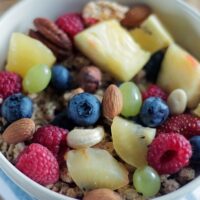(The following article first appeared in the January 19, 2022 issue of Get Healthy, a publication of The Northwest Indiana Times.)
Stress. Everyone has it to some degree. When it takes over your life, eating habits may be turned upside down. Some people lose their appetite and go for long periods of time without noticing hunger. Others eat to distract themselves. Neither is ideal. If you happen to be the type that turns to food for comfort, these tips will hopefully help you the next time you find yourself eating to soothe, rather than because you’re physically hungry. 
Stress causes the body to produce the hormone cortisol. We need cortisol to help regulate metabolism, the inflammatory response, immune function, memory, and more. In the days when we had to seek food in the wild and fight off danger, cortisol was beneficial in helping the body store up necessary fuel in times of scarcity. Too much or too little causes problems. When cortisol levels are elevated, as can occur with chronic stress, metabolism slows, sleep may be disrupted, and blood sugar levels are not well managed. All of these can lead to unwanted weight gain.
In stressful or emotional times, eating is a feel-good activity that provides temporary relief to a problem. Unfortunately, the food never solves the problem and often produces feelings of guilt and helplessness. This leads to more eating, and so goes the vicious cycle.
Tip #1: Give yourself permission to overeat
While I refer to these as “tips,” they are actually experiments for you to try so that you can discover what works best for you. When you allow yourself to eat the entire bag of chips and not feel bad about it, you may find that you don’t need more than a handful. Here’s the catch: take note of how you were feeling and what happened prior to you having a strong desire to go to your chosen comfort food. Noticing what triggers you is the first step to learning about your behavior. It may take some time for you to determine what the underlying cause is, and there may be several. However, sometimes simply naming the problem can lead to stopping the cycle. Once you determine the trigger, figure out what you can do about it.
Tip #2: Be prepared for the next thing
If you have a history of stress eating, odds are good that it will happen again. The trigger may be different, or not, and you’ll find comfort in the depths of a cookie jar. That may still happen; however, the idea is to have a list with some things you can choose to do before you head for the cookies. These things can take anywhere from one to fifteen minutes and help fill a void that you use food to fill. When you discover what else helps bring you comfort in times of stress, you may find that you eat fewer cookies.
Tip #3: Keep more nutritional stress foods handy
Even though cortisol tends to increase cravings for fat, sugar and salt, you could try some other food options first. The key is having them ready in case of a stress eating attack. If you’re a fan of crunchy and fatty snacks, try celery stalks with peanut (or your favorite nut) butter; instead of ice cream, try Greek yogurt with granola or nuts; chocolate fans could eat dark chocolate with a higher cocoa content and less sugar. By trying other options, even if you end up heading for the chips, ice cream, or M&M’s, you may be full enough that you’ll eat less. It’s about better, not perfect. 
Tip #4: Eat nourishing foods throughout the day
When you feed your body the nutrients it needs during the day, you’re more likely to keep your blood sugar and emotions in check, and you’re less likely to hit bottom. Exercising regularly and getting plenty of sleep are also helpful for handling stress.
Tip #5: Offer yourself the same compassion that you would a friend
In other words, stop beating yourself up with negative self-talk. I once heard someone say that if we talked to our friends the way we talk to ourselves, we wouldn’t have any. Stress and negativity cause the brain to release dopamine which is involved in habit creation and the addiction pathway. As a result, this feeds the continuous cycle of more stress eating and feeling bad. Self-compassion offers a way to break that cycle.
The practice of self-compassion is not a way to let yourself off the hook and ignore what’s happening. It is a way to be honest with yourself about what’s driving you to eat and being kind to yourself in spite of it. You are aware of what you’re doing without judgement; you understand that this is a common feeling with most of humanity; you are kind to yourself, the way you would be kind to your friend. By letting go of the guilt, you can minimize stress eating.
Preparing for the next thing
Before you stress eat, pause, and try one or two other activities first. Each activity can take anywhere from about 1 to 15 minutes. Choose things that you enjoy and believe that you’ll actually do. What works to keep you away from your pantry or fridge one day may not work on another, depending on the stressor, your mood, the day. Be open to experimentation and be flexible. Here are a few ideas to get you started so that you can come up with your own list. Once you create your list, keep it handy for those stress emergencies.
- Read a few pages of an engaging book
- Phone a friend
- Close your eyes, sit quietly, and breathe
- Play with your pet
- Go outside for some fresh air
- Do some stretches or push-ups
- Listen to your favorite music
- Write a brief note to someone who would love to hear from you
- Journal about what’s driving you to eat or about your happy place
- Sort through mail
- Vacuum a room or toss in a load of laundry
- Drink a glass of water










